Whisky Route #5: A Hebridean Whisky Trail
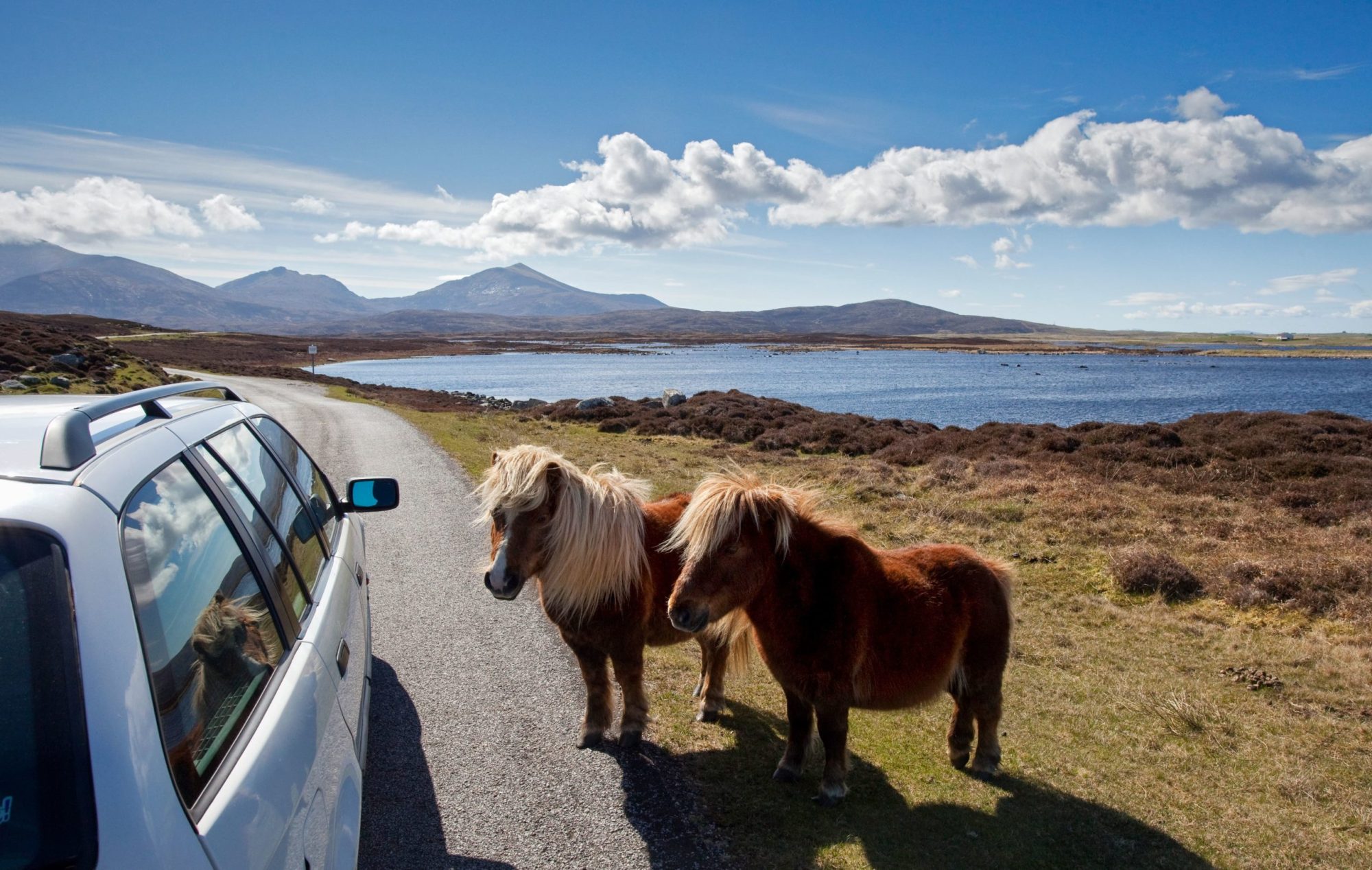
After dipping our taste buds into the flavours of mainland Scotland, it is now time to sail off and make our way through one of the most precious treasures of this country: the Western Isles.
Scotland’s majestic and windswept west coast comprises hundreds of scattered islands and small skerries. It is a landscape of rugged shores and white beaches inhabited by thriving wildlife, small fishing harbours, and numerous peat bogs.
The islands are also bustling with distilleries, new and old, in all their beauty, making it an exciting trip for the whisky lover.
And now, ladies and gentlemen, let’s hoist the sails and head for an island-hopping journey…
Chilly tropics: the Outer Hebrides

Isle of Lewis – Photo: VisitScotland
In less than three hours, the ferry from Ullapool will take you through the Minch, the stretch of water that divides the Outer Hebrides from the mainland, to reach Stornoway, the main town on the islands of Lewis & Harris. This archipelago is a place of rare beauty, where you’ll find beaches that equal Caribbean postcard landscapes in beauty. However, bear in mind that the temperatures won’t be as warm, so plan on cosy layers and windproof jackets rather than a swimsuit, unless you are brave enough.
Being relatively remote, these islands haven’t been on the whisky tourist radar for a while; however, several new exciting distilleries are reigniting the passion for the water of life in the area.
One of them is Abhainn Dearg Distillery, on the west coast. This is the first distillery on the Island since 1840, when the old Stornoway distillery was closed down. This is a properly tiny distillery, and although it somewhat lacks the elegance of some of the newest, cutting-edge design distilleries, it is worth a visit to discover their whisky-making methods and take a walk around the beautiful and remote surrounding area.
A short drive from here, you can visit the Calanais Standing Stones, a Neolithic monument predating even Stonehenge. If you are looking for unusual and interesting accommodation, check out the Gearrannan Blackhouse Village, a historic group of houses originally inhabited by crofters.
Heading down to the Isle of Harris, you could seize the opportunity to get a bargain on some local products such as Harris Tweed.
In Tarbert, you can also visit another new whisky business, the Isle of Harris Distillery. Nestled on a firth, the distillery’s outlook reminds one of a cross between a cathedral and a traditional house. The distillery is now very popular for its gin (which you can buy only from the Island), and the first spirit for whisky flowed here in December 2015. Tours are available, and spectacular coastal views are surely on the menu.
Make sure you have time to visit the gorgeous Luskentyre Beach or one of the many historic sites on the Island.
From Tarbert, you can take the ferry to the southern part of the Outer Hebrides, starting from North Uist.
Gin lovers will be happy to find the North Uist Distillery Co., which produces Downpour Gin, and can only be purchased here.
A tour of the other southern Islands (Benbecula, South Uist, Castlebay) is thoroughly recommended if you have time, as they are thriving in striking natural beauty and wildlife – but now, let’s follow the whisky trail and take a ferry from Uist to the Isle of Skye.
A tale of fairies: The Isle of Skye

Portree Skye – Photo: VisitScotland
Possibly, and with reason, one of the most popular visitor attractions on the West Coast, the Isle of Skye is a rare coastal beauty and has some of the most incredible views in the country. I would recommend something to hold your jaw, as it will be dropping often during this part of the journey.
It is a paradise for outdoor lovers, climbers, runners, wildlife spotters, and whisky drinkers.
Skye is home to the very popular Talisker Distillery, which overlooks the placid waters of Loch Harport. The distillery buildings are somewhat austere, but the location has a dramatic and picturesque touch, and the tours are thoroughly recommended, especially if you like a coastal and smoky dram. Outside the distillery, there is also a small, lovely cafe with some tables, making an excellent spot to rest and admire the surrounding landscape. Not far from here, you can also reach the famous Fairy Pools, a group of crystal-clear water pools with some incredibly scenic waterfalls (some are also a great place if you are into wild swimming).

Talisker Distillery – Photo: Diageo
Not to be missed on the Island are the otherworldly landscapes visible from the Old Man of Storr, the impervious peaks of the Cuillins, and the colourful village of Portree.
It is worth perusing the lovely selection that Isle of Skye Brewing offers, which also includes a local Skye Gin. If you are in Sligachan, however, before heading for a hike, you should stop at Seumas’ Bar at Sligachan Hotel: not only is the food lovely, but the whisky selection is excellent, and they have freshly brewed ales from their neighbours at Cuillin Brewery.
However, bear with us, as one can easily hop across the water to visit a new addition to Skye’s distilling family. Nestled on the shores of the small Island from which it takes its name, Isle of Raasay Distillery has one of the most spectacular views from its brand-new visitor centre. The first spirit was distilled there in 2017, and their inaugural release was introduced to the market in winter 2020. The building is beautifully renovated: a former Victorian Hotel now hosts part of the distillery, which offers accommodation with several rooms for a full-on whisky immersion.
But wait, we’re not quite done with Skye yet. In 2017, a second spirit started flowing on this Island, more precisely at the very new Torabhaig Distillery, which was set up in a converted 19th-century farmstead. There is something incredibly charming about the balance and neatness of this place, situated in a picturesque, remote part of the Island. A great last taste of developing spirit before we hop on a short ferry and make our way (only briefly) to the mainland.
A mainland pit-stop: Ardnamurchan peninsula
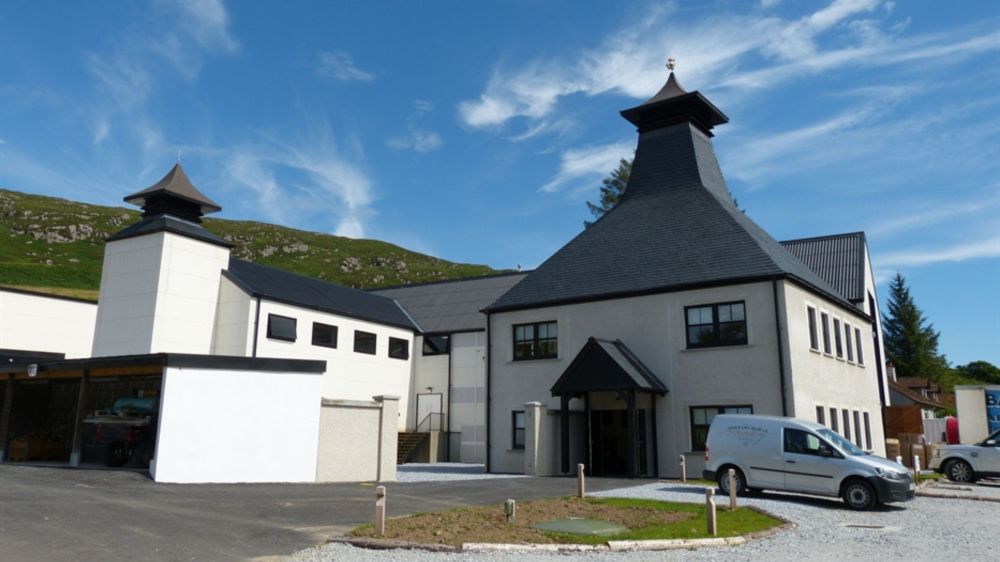
Ardnamurchan Distillery – Photo: VisitScotland
We now leave behind us the beautiful islands for a quick mainland pit-stop. Heading south while following the coast, we drive through the stunning Lochaber area, stopping only when we reach Loch Sunart: say hi to Ardnamurchan Distillery. Owned by independent bottlers Adelphi, the distillery was founded in 2014 and aims to be one of Scotland’s most environmentally friendly whisky producers, earning it the title of “Scotland’s greenest distillery”. It is a place of beauty, and the owners supply a great selection of independent bottlings to taste while their spirit waits to be ready and mature.
Look around the area, which has hidden castles and great hikes nearby.
But now, we are back at sea.
Mull-ed whisky
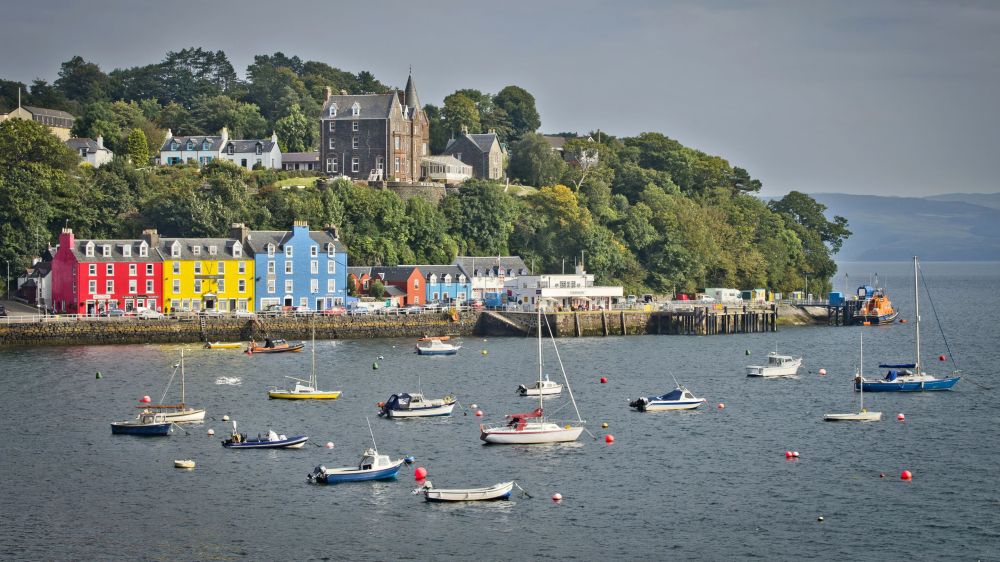
Tobermory – Photo: VisitScotland
Just heading further down the Ardnamurchan peninsula, you’ll reach Kilchoan, where you can get a ferry to the stunning Isle of Mull. Wildlife enthusiasts revere this Island, but it is also a fascinating pilgrimage for whisky lovers. As soon as we hop off the ferry, we can head to the distillery of Tobermory. This is a bonnie and quite an unusual view – the distillery overlooks the fishing village, with a waterfront reflecting the colourful and lively houses. The distillery produces both an unpeated single malt (Tobermory) and the fiercely peaty spirit Ledaig (pronounced Lah-chig) – and you have two very opposite spirits here, one fruity and mellow, the other oilier and seaweedy. They also produce a signature gin. All of this pairs perfectly with some locally produced Mull cheddar and seafood. For history lovers, a visit to Duart Castle is a must.
For a complete island experience, though, we highly recommend exploring the Island around Mull. Iona is undoubtedly not to be missed if you are in the area, with its medieval abbey, which makes an excellent place for history lovers. Just across the water, Staffa is uninhabited and a wonder of geology: it nestles Fingal’s Cave, which is made of the same hexagonal rock columns that form the Giant’s Causeway in Northern Ireland.
Back to Mainland Coast: city & farm

Photo: Ncnean Distillery
It is worth returning to the mainland, as a couple of new and old whisky gems await us.
From Tobermory, we can jump on a ferry to Drimnin and find ourselves on the Morven Peninsula: think remote, and it will probably not be as remote as it gets here.
Well, a young distillery has recently spread its wings on this beautiful land by the sea and started making fully organic whisky. I am talking about Nc’nean Distillery, which was founded by Annabel Thomas and named after a Queen of the Fairies. The setting of this new distillery, which has released its first whisky this year, is stunning and has the feel of a cosy cottage that shelters you from the winds. Entirely based on being sustainable (100% powered by renewable energy), it is a milestone of what the new wave of distillers can offer regarding technology and innovation.
While you are here, you will want to visit and get lost in these stunning coastal landscapes in the wilderness. Then, hop on another ferry in the direction of Oban.

Oban Distillery – Photo: VisitScotland
From a brand new and shiny distillery lost in the middle of nowhere, we go to the ancient roots of a distillery’s craft in the town centre. Oban is a lovely port; the distillery breathes and lives with it. Oban Distillery is undoubtedly a great place to learn more about whisky, another big name for coastal whisky lovers, with a mild whiff of peat and untempered spiciness in its drams. Set in traditional white buildings, it’s easily accessible and offers very entertaining tours.
I recommend a stroll on the seafront combined with a tasty bite before embarking on any of the islands that lie ahead—ferries from here can reach eleven different ports, making it a great hub for visiting Scotland’s coastal beauties.
A visitor’s delight: Arran

Photo: Lochranza Distillery
Time for a long but worthy car detour (which, in fairness, may be welcomed by those less keen on ferries). Head south to join the A83 and go straight down to reach the stunning Kintyre Peninsula. Glimpses of the sea and wilderness will appear like a present from this. Aim to reach Claonaig, where we’ll get the short ferry to Lochranza, on the Isle of Arran. This is a top spot for Glaswegian holidaymakers and tourists alike. The island hovers in the waters of the Firth of Clyde and, sheltered by the Kintyre peninsula, has a relatively mild climate (for Scottish standards!). Lochranza is lovely, but what’s most interesting to us is Arran Distillery: with a delightful cafe serving tasty food if you need a refill between a dram and the other, the distillery produces a round, fruity and fragrant whisky, quite unlike the usual coastal beasts. This is one of the most visited distilleries in Scotland, and for a few good reasons, it blends the beauty of the setting, the taste of the dram, and the accessibility of Glasgow. What’s even better is that a second distillery, planned as an expansion, has been built south of the island: Lagg Distillery, which is dedicated to producing peaty whisky!
If you need a pause from spirits, you can get a lovely chaser from Arran Brewery before going to our last stop, on the Kintyre peninsula.
Regional threesome: Campbeltown
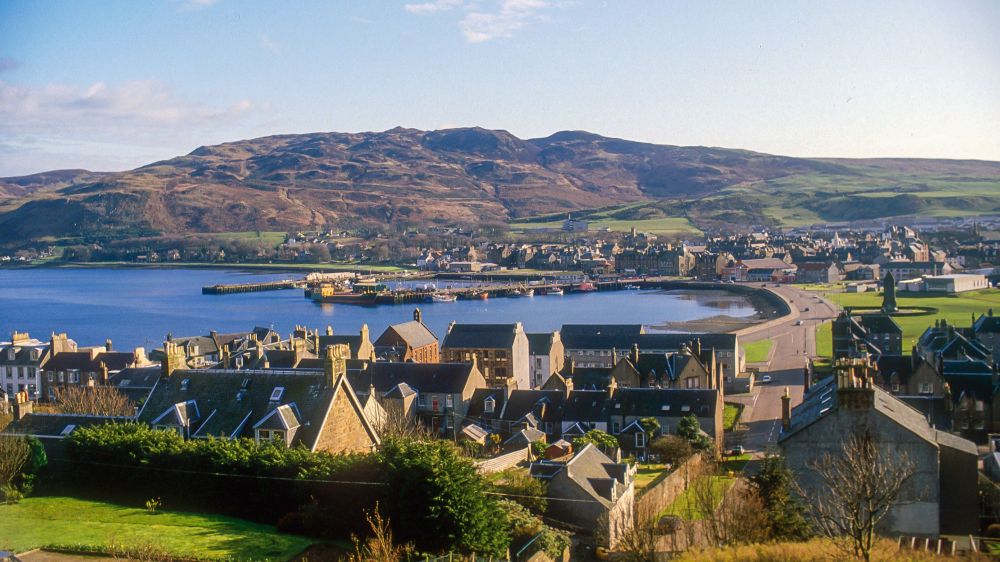
Campbelltown – Photo: VisitScotland
Our last stop is a whisky region in its own right, known for whisky with a briny yet spicy character, and one that has become popular despite counting only three distilleries. But don’t be fooled: at its prime time in the early 1800s, Campbeltown counted for about 34 distilleries.
Today, the only three distilleries remaining, interlaced in the town’s urban landscape, are two traditional pillars of the area, Glen Scotia and Springbank, and the newest addition would be Glengyle. Since there is almost one across the road from each other, it would be rude not to have a wee taster of each of them.
But let’s go through them in order: the oldest in town is Springbank Distillery, and there is much about vision and entrepreneurship in this spot. This family-owned distillery has been around for so long (200 is not a bad result, right?). They were among the first to brand differently spirits with a different character, starting with their peated Longrow and going to the triple-distilled Hazelburn – a dichotomy that today one can find in Tomatin/Cu Bocan, Tobermory/Ledaig, Edradour/Ballechin and so on. The current owner eventually acquired the premises of Glengyle Distillery, which was closed for years and brought back to life, now producing Kilkerran.
There are many reasons for visiting here: you can see one of the few operational floor maltings, try many different whiskies with different characters, and the choice of tours is wonderfully varied.
If that was not enough, the same company owns the independent bottler Cadenhead. If you fancy a 360 exploration of the world of whiskies, with rums, cognacs and other spirits, that’s the place for you.

Springbank Distillery – Photo: VisitScotland
Back to the distilleries—we shall now head to the second oldest one in town: Glen Scotia Distillery. Back in the day, it was mainly used to produce whisky for blends. However, the roots of the Glen Scotia we know started only in 1999 when the Loch Lomond group acquired it. It is a lovely cottage-like building outside, on the other side of the town from Springbank. The briny character comes through here in the whiskies.
Since you’ve come such a long way, I’d recommend exploring the surroundings of Kintyre, maybe indulging in some gin tasting at Beinn Ann Turc distillery and enjoying the scenery around.
Finally, it’s time to head to Kennacraig for the last long ferry of our journey: we are heading to the mystic charms of Islay.
FESTIVALS & EVENTS
Campbeltown Malts Festival
The festival usually runs the days before the Islay whisky Festival in the middle of May, so that whisky lovers can combine an extended stay in the area and enjoy the two festivals.
Open days, masterclasses, and gatherings will make your day in the town’s distilleries.
Hebridean Whisky Trail Festival
With the Hebridean whisky trail connecting theoretically the distilleries of the Hebrides (Isle of Harris, Torabhaig, Talisker, and Raasay), this very new and exciting festival is the answer to the Islay or Spirit of Speyside. It takes place in mid- to late May.
Arran Malts&Music Festival
A beautiful summer festival in June celebrates whisky, music, and the Island—there is plenty of fun to be had!
Whisky journey top tip #5: Immerse yourself in the local community
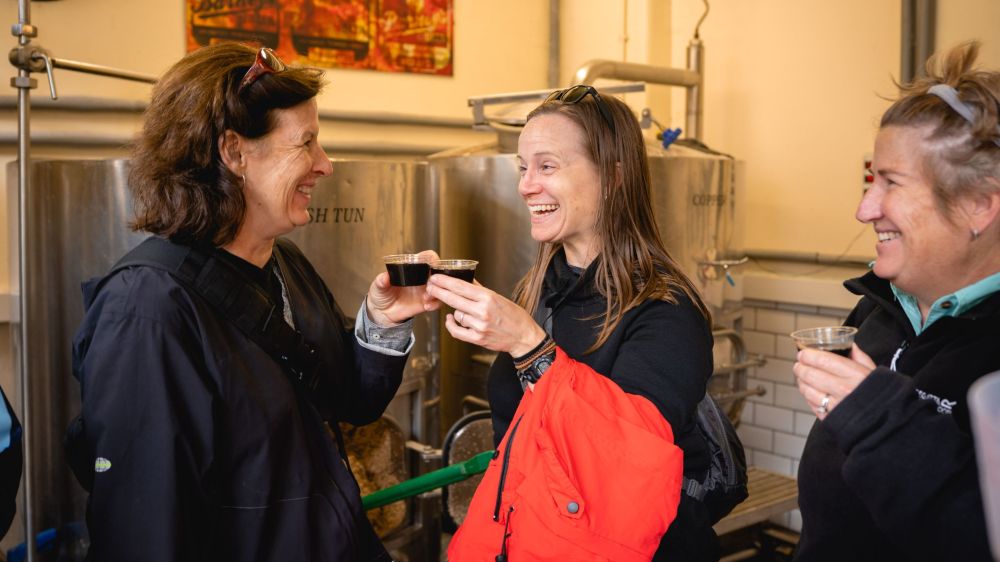
Photo: Once Upon a Whisky
One of the best things about the whisky industry is the convivial spirit that surrounds it, and the stories behind the whisky. If you have the chance, speak to the locals when you are around, and you may be rewarded with fascinating stories that will make your whisky journey even more memorable, especially as some of these communities live and breathe around the production of our beloved water of life!
Continue reading…
Whisky Route 1: The North Coast 500
Whisky Route 2: The Malt Whisky Trail: Speyside [World’s Whisky Capital]
Whisky Route 3: Whisky Hopping Across the Highlands
